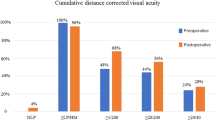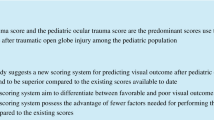Abstract
Purpose
Rotating wire brushes are used, e.g., for rust removal. Detaching fragments can cause severe eye injuries. The purpose of this study was to investigate mechanism, severity, clinical outcome, validity of Ocular Trauma Score (OTS) and to assess the likelihood of final visual acuity.
Methods
Twenty patients with traumatic ocular injuries by rotating wire brushes were included. Location and type of injury, grade of injury according to OTS, surgical procedure, and development of visual acuity were evaluated.
Results
Eleven accidents (55%) happened at work, nine at home (45%). Eighteen injuries (90%) were penetrating, one (5%) was perforating. In one case (5%), an intraocular foreign body was present. One case each was classified OTS 1 and 2 (5%), six cases OTS 3 (30%), four cases OTS 4 (20%), and eight cases OTS 5 (40%). None of the patients was wearing safety goggles. Fourteen patients (70%) were surgically treated. Of these, five were treated at the anterior segment only, nine additionally underwent pars-plana vitrectomy. Nine patients received phacoemulsification. Mean best corrected visual acuity was logMAR 1.0 (2/20) at admission and 0.3 (10/20) at last follow-up. Our results were similar to those in the OTS study, except for OTS 1 (p = 0.046). Comparing the categorical distribution of final visual acuity in all OTS categories, no statistically significant difference was found (p = 0.119) between our results and the OTS study group.
Conclusions
OTS may provide prognostic information in traumatic ocular injuries by rotating wire brushes. The injuries could have been avoided by wearing safety goggles.



Similar content being viewed by others
References
Schrader WF (2004) Epidemiology of open globe eye injuries: analysis of 1026 cases in 18 years. Klin Monbl Augenheilkd 221(8):629–35
Kuhn F, Morris R, Witherspoon CD, Mester V (2004) The Birmingham Eye Trauma Terminology system (BETT). J Fr Ophtalmol 27(2):206–10
Framme C, Roider J (1999) Epidemiology of open globe injuries. Klin Monbl Augenheilkd 215(5):287–93
Mönestam E, Björnsti U (1991) Eye injuries in northern Sweden. Acta Ophthalmol 69(1):1–5
Höh H, Krannig HJ (1990) Perforating injuries of the eyes caused by rotating steel brushes. Klin Monatsbl Augenheilkd 196(3):166–70
Hassett P, Cleary PE (1994) Serious eye injuries caused by rotating wire brushes. Br J Ophthalmol 78:491
Hod Y, Geyer O (2005) Eye injuries caused by rotating wire brushes. Harefuah 144(4):239–40, 304
Purtskhvanidze K, Klettner A, Roider J, Rüfer F (2013) Open globe injuries by rotating wire brushes. Acta Ophthalmol 91(8):e653–4
Kuhn F, Maisiak R, Mann L, Mester V, Morris R, Withersspoon CD (2002) The ocular trauma score (OTS). Ophthalmol Clin N Am 15(2):163–165
Sobaci G, Akin T, Erdem U, Uysal Y, Karagül S (2006) Ocular trauma score in deadly weapon-related open-globe injuries. Am J Ophthalmol 141(4):760–1
Unver YB, Kapran Z, Acar N, Altan T (2009) Ocular trauma score in open-globe injuries. J Trauma 66(4):1030–2
Meng Y, Yan H (2015) Prognostic factors for open globe injuries and correlation of ocular trauma score in Tianjin, China. J Ophthalmol 2015:345764
du Toit N, Mustak H, Cook C (2015) Visual outcomes in patients with open globe injuries compared to predicted outcomes using the Ocular Trauma Scoring system. Int J Ophthalmol 8(6):1229–33
National Society to Prevent Blindness (1980) Vision problems in the U.S.: Data analysis, definitions. Data sources, detailed data tables, analysis, interpretation. National Society to Prevent Blindness New York 25–26
Tielsch JM, Parver L, Shankar B (1989) Time trends in the incidence of hospitalized ocular trauma. Arch Ophthalmol 107(4):519–523
Wong TY, Tielsch JM (1999) A population-based study on the incidence of severe ocular trauma in Singapore. Am J Ophthalmol 128(3):345–351
Smith AR, O’Hagan SB, Gole GA (2006) Epidemiology of open and closed-globe trauma presenting to Cairns Base Hospital, Queensland. Clin Experiment Ophthalmol 34(3):252–9
Cillino S, Casuccio A, Di Pace F, Pillitteri F, Cillino G (2008) A five-year retrospective study of the epidemiological characteristics and visual outcomes of patients hospitalized for ocular trauma in a Mediterranean area. BMC Ophthalmol 22:6–8
Geratewohl SJ, Strughold H (1953) Motoric response of the eyes when exposed to light flashes of high intensities and short durations. J Aviat Med 24(3):200–207
Author information
Authors and Affiliations
Corresponding author
Ethics declarations
Funding
This research received no specific grant from any funding agency in the public, commercial or not-for-profit sectors.
Conflict of interest
The authors declare that they have no conflict of interest.
Ethical approval
All procedures performed in studies involving human participants were in accordance with the ethical standards of the institutional and/or national research committee and with the 1964 Helsinki declaration and its later amendments or comparable ethical standards.
Informed consent was obtained from all individual participants included in the study.
Rights and permissions
About this article
Cite this article
Purtskhvanidze, K., Rüfer, F., Klettner, A. et al. Ocular Trauma Score as prognostic value in traumatic ocular injuries due to rotating wire brushes. Graefes Arch Clin Exp Ophthalmol 255, 1037–1042 (2017). https://doi.org/10.1007/s00417-017-3629-6
Received:
Revised:
Accepted:
Published:
Issue Date:
DOI: https://doi.org/10.1007/s00417-017-3629-6




